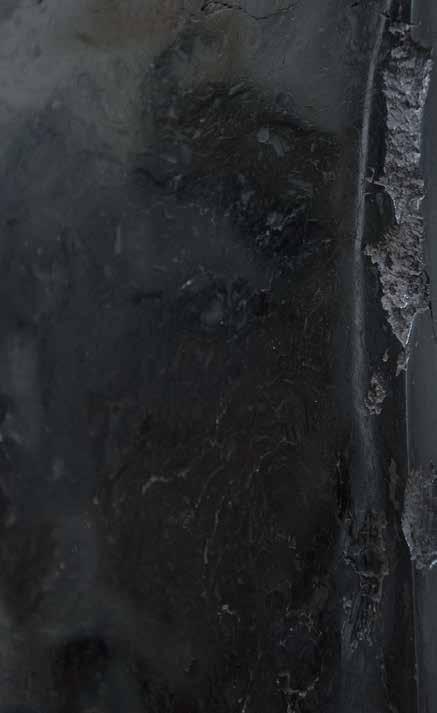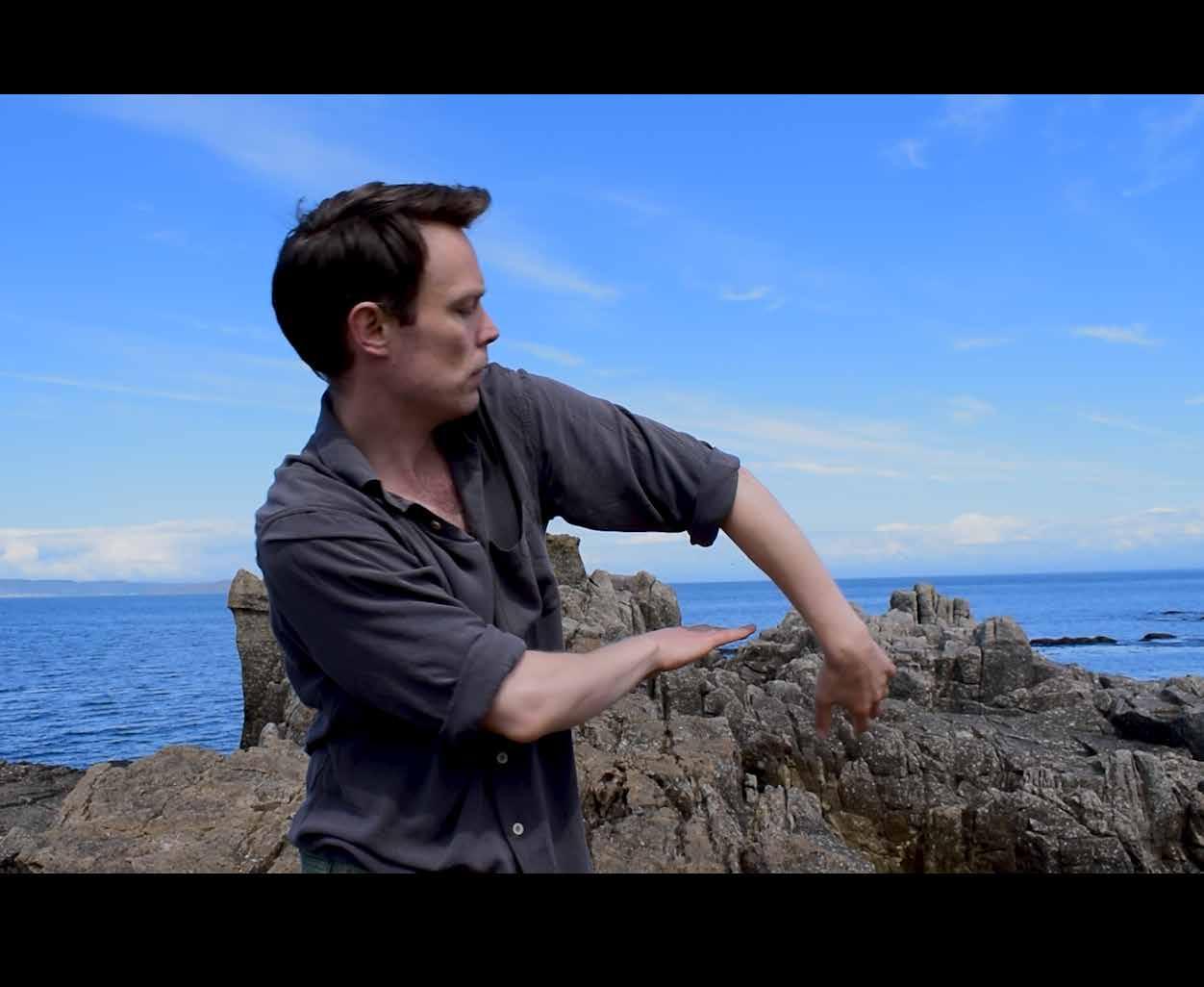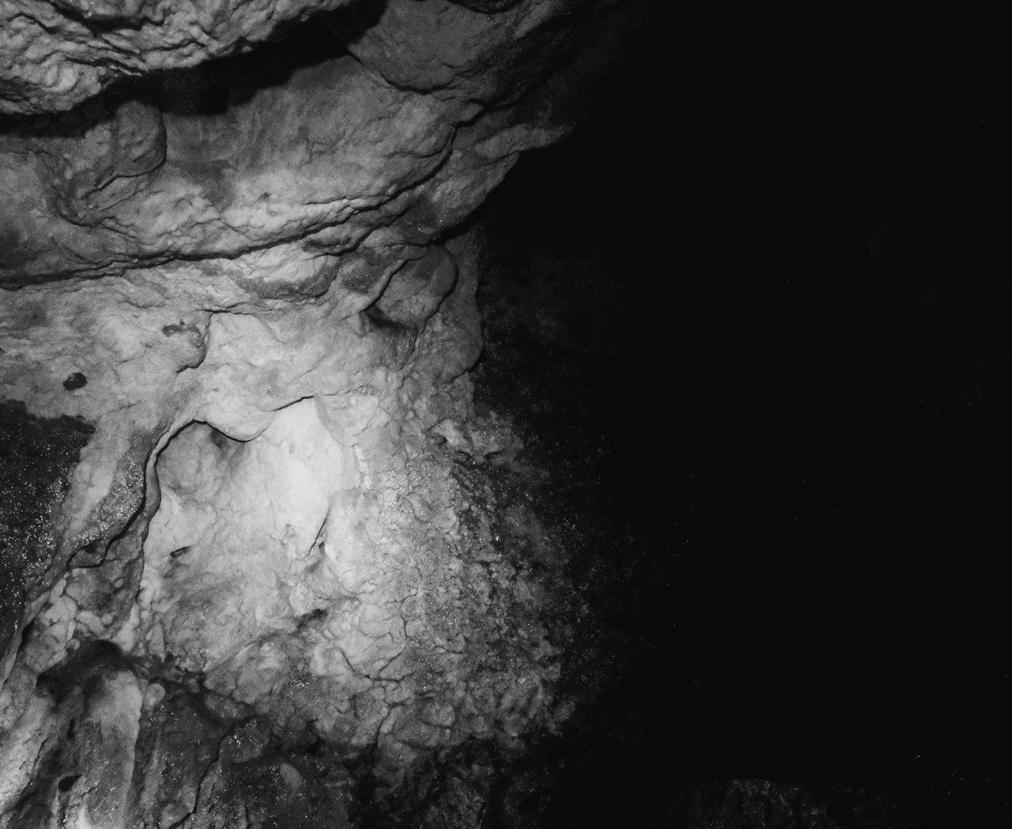MASTER EXTRACTION
Jennie Taylor

 Cover: Caoimhe Kilfeather, Inky Canopy (detail), 2011, Polished carved coal
Above: Nollaig Molloy, Worth your Salt, 2020, Video still
Cover: Caoimhe Kilfeather, Inky Canopy (detail), 2011, Polished carved coal
Above: Nollaig Molloy, Worth your Salt, 2020, Video still


 Cover: Caoimhe Kilfeather, Inky Canopy (detail), 2011, Polished carved coal
Above: Nollaig Molloy, Worth your Salt, 2020, Video still
Cover: Caoimhe Kilfeather, Inky Canopy (detail), 2011, Polished carved coal
Above: Nollaig Molloy, Worth your Salt, 2020, Video still
Jennie Taylor
A text in response to EXTRACT
Padraig Cunningham
Caoimhe Kilfeather & Nollaig Molloy
Roscommon Arts Centre
January 27th – March 24th 2023
 Padraig Cunningham, Surfacing 7, photograph, 2021
Padraig Cunningham, Surfacing 7, photograph, 2021
The researchers were looking in the wrong direction. They were searching for particular particles’ activities inside of water, which they believed had an ability to measure the rate of climate threat. As they were investigating the particles, it was discovered that it wasn’t water that they were looking for; it was gold leaf but not any gold leaf— a version that had been living in the company of dried proteins in which a subtle change takes place in the gold, introducing a spectrum of colour that acts as a barometer to indicate the threat of wildfires, changes in river flow, intense storms and extreme rainfall. Someone anonymously communicated this discovery in a clearly written letter using the appropriate scientific language. Convinced, the researchers pivoted their project to see for themselves.
It was the year 2073. The only places where they could find gold leaf in this kind of habitat was in art museums. Most of them were abandoned and were more like train stations with no trains or like parks at night. There were no locks, no security, no staff, no electricity, but lots of space and shelter. During unseasonal heat, their stone and concrete interiors were ideal places to rest
inside of clean shapes of shades and angular nooks. Museum collections of mostly paintings, prints and sculptures were now surfaces to lean onto. Greasy residues from heads of wiry hair were visible on large, low hanging works. The paintings offered a metaphorical warmth, not heat, but company. They depicted powerful families, leaders, distinguished people who were now exclusively sharing space with those seeking shelter at night and hiding places in the day. Museums became waiting rooms for something that had already happened.
Leaves and stuff and rubbish gathered around the front lawn of the museum entrance. All the building’s electronic systems which had sophisticatedly operated beneath its clinical lawn were now populated with accidental wildflower and with nothing underneath but a silent hum of worms happily unaware of what had been. The researchers could access the museum with ease. They didn’t know which paintings had gold leaf. Feeling confident that they could use their own gaze, their own eye, to identify the gold, they rushed inside, which was dramatic because they had allowed time for this. One of them wondered if the rush was
some kind of unconscious effort to reinject purpose, value, and meaning into the museum. They ran like the rate and the force of a sudden burst of flooding water into a building and they were curious about their own urgent behaviour. Nothing was chasing them, but they were acting as if there was.
Without having to look very far they found a particular room which had several works with gold leaf and egg tempura. They brought a bespoke device to carry out the extraction. The device was elegant in this space. It was a white, polished, cylindrical, long handheld device. Maybe a little like a telescope. This group of researchers was roughly six or seven people, so when one person was using it there was a slight lull for everyone else. Some of them took that opportunity to look around at the other artworks. Others observed the device with more interest. The researcher who was using it first was the designer and so it seemed fair that they got to try it out.
They looked through it at one end. A mixture of their intention, the convex form of their eye and the blink of their eyelid, was to be detected by a sensor built into the device. To capture a mixture of these three things (intention, form and movement) they had to trust that the device was going to sense this in real time. They had tested this in their lab, but now; it felt different being in the real scenario looking at an artwork. They were unsure if their intention only went as far as wanting to extract the gold leaf. They weren’t too worried about the form and the movement because these were verifiable.
When the process was working, the device would activate extraction of the gold leaf without interfering with the overall artwork. The sample required was tiny and likely to go unnoticed. The fellow researchers questioned why this mattered since the artworks no longer had viewers. The researcher who made the device wanted to show off their ability to do something as sophisticated as this. They didn’t really care that much if they interfered with the artwork as they saw this as an excuse to be ambitious and precise in what they invented.
The device was designed to produce a very narrow channel of air moving at a fast rate, like a hair dryer, but ice cold and it would be so fast and narrow that when pointed in the correct direction, it could extract a piece of gold leaf. It would soften an already forgiving and resilient material, separating it like a little flake from the rest of its company. Once this takes place, the researcher would spot the flake–however small, the gold leaf would be visible through its shimmer.
All they had to do was rotate the device 45 degrees, and that action communicated to the device that the piece was ready to be captured and retrieved. The airflow would reverse and do a little U-turn, cup the flake and pull it back into the direction of the eyepiece. It was to do this in the right time so that the flake could land. A little capsule was located inside the device at the right spot for when the air deposited it. This was all timed according to the behaviour of a flake of gold and the rate of the flow. The researcher was still waiting, and they weren’t feeling the action. Their intention, form and movement of blinks were not registering just yet. They didn’t want to move to another work that had gold leaf because they felt like they
were labouring their stare over this artwork through the device for several minutes now and they were more likely to conjure up a genuine intention with this work in which their gaze was packed with desire to see it.
They looked at the actual piece with slight concern that intention would not be detected, so they focused on it. They struggled to care. The piece depicted a figure on a white horse. A disembodied hand featured in the right corner and a half-bodied figure on the left. Another creature lay below the horse, a dragon looking up, and spewing fire. White geometric forms filled the background, suggesting snow-capped mountains. The two figures had a wide band made of gold leaf around their heads. The researcher’s gaze flitted from curly greys, to generous reds, to spikey trees, ears, and flames.
They felt the airflow and looked carefully for the extracted piece, but it didn’t flicker the way they anticipated. It lost its shimmer by no longer being flat on a surface. The researcher hadn’t really considered what it’s like when it is an autonomous piece of matter. When dislocated and not on display, it goes into itself, becoming
almost invisible. For this reason, they did not see it in time, and they rotated the device a little late. It took longer for the flake of gold to be deposited inside the device, and it failed to land in the capsule. They then thought maybe they should have had a row of capsules, but they were hesitant to show any doubt to their fellow researchers so they acted as if all was well. Concluding the process, they hoped that the little piece was in there and made their way back to the lab. The study was a triumph.
Months later, the researcher returned to the museum, which was still abandoned but showing the beginnings of a new phase of use and self-regulation. They brought the original flake of gold that they extracted during that first visit. Hastily, they pulled at a frame from a large 17th century painting, dislodging the wood. The canvas flopped on one corner. They marched to a quiet spot and made a small square frame, roughly 150 mm x 150 mm, and they carefully mounted the gold flake onto a brilliant white mount card. The 0.0002mm gold was proud of the mount card in its own
thickness. They installed the framed flake onto a blank wall in the museum’s internal courtyard. Unnoticed at first, the piece became a mystery to anyone passing through. As years passed, it became renowned for filling the courtyard with an ecstatic yellow light when the sun met the skylight at the perfect angle and spilled the space with its growing power. The date when this trick and bend of light took place happened to be the same date of the original extraction. The researcher and their team encouraged this day to be a celebration which eventually became a global holiday. The piece remained untitled in the thrown together frame, salvaged from its own history, generating annual glare and daily, quiet respect.
Jennie Taylor is the Roscommon Arts Centre’s Visual Art Writer in Residence for 2022. During this time Jennie is invited to write critical texts on selected exhibitions and projects happening across the county. The intention of this residency is to allow writers to experiment with their writing style and explore new ways of disseminating their work. The writings will be available at Roscommon Arts Centre and online as they are published. Jennie Taylor is a fiction and arts writer. Her practice draws from particle physics, Agential Realism and micro-histories. Areas of concern include proximity, locality, contemporary pedagogies, theorising empirical knowledge, and fictioning art history. A graduate of Dun Laoghaire Institute of Art, Design & Technology, in 2014 she completed her MA, Art in the Contemporary World, National College of Art & Design. She has published her work in Critical Bastards Magazine, The Stinging Fly and Visual Arts Newsletter. Jennie lives and works in Dublin, Ireland.
Padraig Cunningham is an artist and designer living in Roscommon, his work examines physical displacement in the environment. Within this dislocation, themes of loss and absence become apparent often centering on everyday places, their reinventing and questioning their status, usage, and how they have been altered to accommodate human engagement. Implied in this alteration is nostalgia, a longing for what has been lost. The open receptive nature of the work is an attendant to that absence. www.padrigcunningham.com
Caoimhe Kilfeather’s work is predominantly sculptural. Exhibitions sometimes take the form of an environment – the creation of a ‘new place’. Such installations have a reflective presence; they are sparsely appointed with crafted objects that are charged with thoughts, memories and other associations.
Kilfeather is based in Dublin. Her work is held in numerous collections such as the National Gallery of Ireland, Irish Museum of Modern Art, the Arts Council and Office of Public Works. She lectures in Sculpture and Combined Media at the Limerick School of Art and Design. www.caoimhekilfeather.com
Nollaig Molloy is a visual artist from Roscommon. Her arts practice explores materials from specific sites and their relevance in historical, social and industrial situations. She works with video, animation, sculptural installation and event-based outcomes. Through modes of in-depth research, she works with formal and informal archives, environments and communities-ofinterest. Within these areas she explores ideas of conservation, preservation and materials-to-hand within archives, landscape and ecology. Between the months of October and December in 2022, she was an artist-in-residence in Bochum, Germany with the mining trade union archive of Das Haus der Geschichte des Ruhrgebiets facilitated by Urbane Künste Ruhr. During this residency she spent time navigating ongoing archival collections while exploring the many aspects of a closed mining industry. www.nollaigmolloy.com